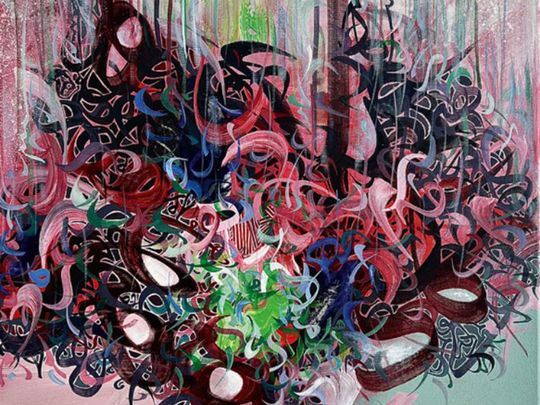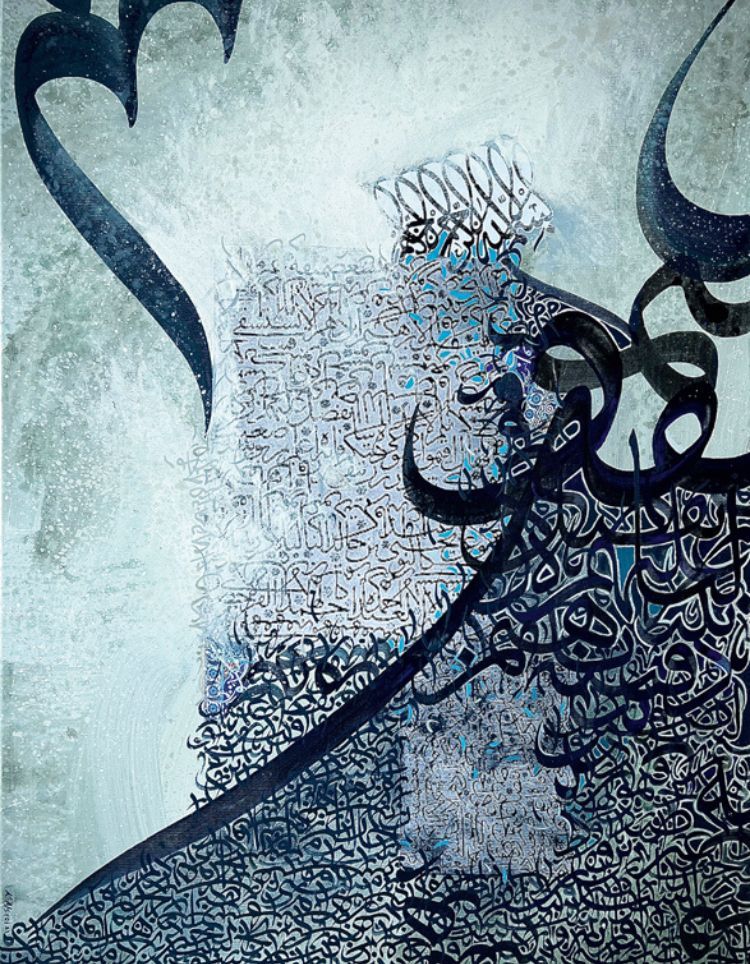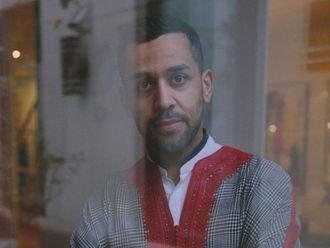
“Calligraphy,” writes Syrian-German author Rafik Schami in the afterword of his novel The Secret of the Calligrapher, “is music for the eye.” Indeed, it is. For centuries, calligraphers from across the Islamic world have used the lines of elegant Arabic script to create forms that appear to dance and sing before one’s eyes evoking happiness and deep contemplation through their movements and colouring. Syrian Sharjah-based artist Khaled Al-Saai, one of the world’s most renowned calligraphers working today, is an example of an artist that uses the traditional genre of calligraphy with twists of contemporaneity to explore present day themes of identity, history, culture and emotion.
Al Saai has just exhibited “Mystical Letters”, a show in Turkey that pays tribute to the work of the great Turkish calligrapher Ahmed Karahisari (1468-1566). The works on view, painted in Al-Saai’s alluring style of swift, rhythmic lines painted in vibrant colours that undulate like waves in the sea, offered a modern interpretation of traditional Ottoman calligraphy through Al-Saai’s contemporary appropriation of Karahisari’s work. In very much a dialogue between past and present, Al-Saai took visitors on an emotional journey through calligraphic form.
“Karahisari’s name, if you compare it to European or Western art, is like the Michelangelo of calligraphy,” says Al-Saai. “I thought there was potential to recreate his work and bring about something new in the present.”
When one beholds masterpieces, explains Al-Saai, “you understand why great quality stands forever. This is why I chose Karahisari and did a work inspired by him. Yet the most important thing was to offer work that brought innovation, dialogue and artistry between me and him.”
The works on show in Turkey did exactly this. They forged a bridge between Al-Saai’s work in the present and the legacy of Karahisari in the past. Additionally, the new calligraphic works by Al-Saai underlined the undying power of the traditional art form of calligraphy that has withstood centuries, reshaped and innovated by the artists that have specialised in the artistic genre.
Al-Saai, now based in Sharjah, was born in 1970 in Homs, Syria. He grew up in a family of artists in Mayadin, a town in south-eastern Syria, known for their love of art and practice of calligraphy. “I imitated my father’s art”, explained Al-Saai, stating how he had a great love for artmaking since he was a child. Copying what his father created piqued his interest in other art forms.

Al-Saai later moved to Damascus, where he earned his master’s degree in fine arts. He then completed a second master’s degree in calligraphy at the Istanbul Research Center for Islamic History and Culture. He has since participated in numerous group and individual exhibitions around the world, including a solo exhibition at the Institut du Monde Arabe, Paris, in 2001. He has also been the recipient of several awards, including the first prize of Diwani Jali Style, Tehran, Iran in 1997; the Modernity Prize for Arabic calligraphy at the first Biennial for Arabic Calligraphy in the Arab World in Sharjah in 2004; the most prestigious award in Diwani Jali style at the Al Baraka Bank Competition in Istanbul in 2005; and the Classic Calligraphy Prize at the second Biennial of Calligraphy in the Arab World in Sharjah in 2006. The various projects he has worked on include an invitation to co-curate the 2008 Sharjah Calligraphy Biennial and exhibitions in Québec, Zurich, Istanbul, Sharjah and Dubai, among others. Over the last few years his calligraphic designs have also been used to decorate the Majlis tent during Ramadan at Jumeirah’s Mina Al Salam in Dubai.
Al-Saai describes the years of study from 1990 to 1997 as an intensive time in which he also studied literature and music. Since 2000, Al-Saai has been working with Syrian musician Khaled Aljaramani and he creates his art often to the various musical styles that Aljaramani plays.
Always looking for new ways in which to enrich and innovate his practice, in 2014 he began also -processing photographs in his large-format paintings. In 2019 he was an Artist in Residence at the The Museum of Islamic Art located in the Pergamon Museum part of the Staatliche Museen zu Berlin. There he created a two-by-eight-meter painting -titled Syria – The Garden of History in the Mshatta Hall. The work was then displayed in the exhibition “Cultural Landscape of Syria – Preservation and Archiving in Times of War”. It reflects and captures the war through a calligraphic painting.
During joint performances Aljaramani plays the Oud and Al-Saai writes his calligraphy live, which is projected onto a screen for the audience via a projector. The calligraphic letters are not often legible but to Al-Saai it doesn’t matter.
“When I use the calligraphic letters in this matter, I free them from their meaning”, he says. Painting in this way also liberates Al-Saai away from the confines of pure script and language. In this way, the boundaries between traditional calligraphy and modern painting are lessened and the two pieces work hand in hand in the creation of beauty.
“I can use the elements of letters as my own visual language to create and to respond to current events such as the Syrian war, the universe and my surroundings,” he adds.
“I can express myself freely without depending on the language itself,” he explains.
Deeply contemplative not just in his calligraphic paintings but also in the way in which he views the world, Al-Saai has lived in the United Arab Emirates since 2004 where he has exhibited several times at The Majlis Gallery, one of Dubai’s oldest art galleries.
He has a great fascination with the written word—its literal and metaphorical significance. He also continues to study and practice the edicts of the seven “pillars” of Arabic calligraphy, Thuluth, Naskh, Tualeeq, Kufic, Diwani, Diwani Jali Jali and Regga that influence his abstract spirit and inspire his art.
Al-Saai’s artistic genius therefore is one that is much defined by the past as it is the present. Calligraphy is a way to bring beauty, music and movement to the world. His artworks, a reflection of his emotions, his childhood discoveries and explorations in adulthood, celebrate the calligraphic genre’s universal appeal. At once spiritual and otherworldly, his dancing forms breathe new energy into all who behold them. As he says, “Calligraphy offers continuous movement.” Indeed, it offers a continuous celebration of life.






